An analysis of the situation will help determine:
- Your vision of what you want to happen
- The challenge you want to address and the context of the challenge
- Who is affected by the challenge
- What behaviors contribute to the challenge
- Who or what influences those behaviors
- With whom you can partner to overcome the challenge
The nine tasks below will enable you to assess the situation, audience and environment and more clearly understand the challenge to be addressed. The Situation Analysis will inform every step of the strategy design to come.
What You Need to Know to Get Started
Strategy Design process: How will you design your strategy? In a large group with a variety of stakeholders? In a small group, with input from stakeholders on a later draft? No matter how you proceed, your situation analysis should be completed prior to the start of a Strategy Development Workshop or before your working group tasked with developing the strategy begins its efforts.
Formative Research: If existing data is not sufficient, is out-dated, or does not provide enough insight into the challenge or the identified priority group(s), you may need to conduct additional research. Additional research may enable you to fill the gaps in your knowledge through survey data, review of grey literature or use of qualitative research tools such as focus group discussions, key informant interviews, observation checklists, PEER methodology and visual projection. If additional information is needed and formative research is required, the data should be made available prior to the start of strategy development.
Process: Facilitated discussion
Output: Shared vision statement
The vision will anchor your strategy by stating what you hope to achieve. Your vision should be agreed upon by the stakeholders involved in the strategy design process and will thus be “shared” by all. This shared vision statement clarifies what is important, illustrates what you want to happen in the future, and guides the strategy design and development process.
- If someone goes to your community (or country or location) x years from now, what do you want that person to see?
- Is your vision likely to secure commitment strong enough to overcome any obstacles?
- Is this vision shared by all stakeholders (households, government and community)?
Shared Vision Example
 See how the Urban Health Initiative in India clarified their vision.
See how the Urban Health Initiative in India clarified their vision.Write your shared vision in the form of a story or in a descriptive paragraph.
Output: Core challenge(s) that will guide the strategy design.
The core challenge you identify is the key constraint that is blocking achievement of your vision and will be the focus of your SBCC efforts. It is best to focus on one specific challenge at a time.
Sometimes, the challenge will already be identified, such as when a funder releases a request for proposals targeting a particular health issue or when a Government Ministry requests specific technical assistance. Other times, you may need to identify the core challenge.
Most challenges have many underlying causes and thus, potentially, many solutions. It is therefore important to tease out the primary or root cause in order to determine the main reason for the current situation. The constraints or root causes are the reasons why there is a difference between current situation (where we are now) and the shared vision (where we want to be).
A number of root cause analysis tools are available to help visually capture these root causes and their effects and to highlight the relationship between them. Two that will be explained here are the Fishbone Diagram and the Problem Tree . Both present the same information but use different visual representations. Both encourage an in-depth exploration of the challenge through a participatory process and can be conducted with project beneficiaries, stakeholders and/or with those most affected by the challenge. Brainstorming techniques, focus group discussions, ranking or scoring can be used to achieve this.
These tools challenge you to answer the question “Why?” as you identify each cause. By defining the challenge and analyzing and prioritizing its causes, you will begin to understand why the current situation exists and can explore how to address this root cause through your choice of solutions. This process encourages you to keep asking “Why?” until it is no longer practical to continue. Keep in mind that your answers to “Why?” will need to be communication-focused and something you can address within your time-frame and budget. For example, strengthening family planning commodities might be better addressed through a service delivery strategy while addressing misconceptions on specific family planning products could be addressed through a communication strategy.
The Fishbone Diagram, as the name suggests, looks like the skeleton of a fish.
- Begin with the challenge. Write the challenge down as the head of the fish.
- Why is this a challenge? List the factors that contribute to the challenge and draw each as one of the fishbones.
- To delve deeper, you can then identify possible causes for the factors, which are shown as smaller lines coming off the bones of the fish.
A Problem Tree can also help you visualize the causes and effects of your challenge. As the name suggests, the visualization below resembles a tree: the tree trunk represents the challenge, the roots represent the causes and the tree branches represent the effects or the impact.
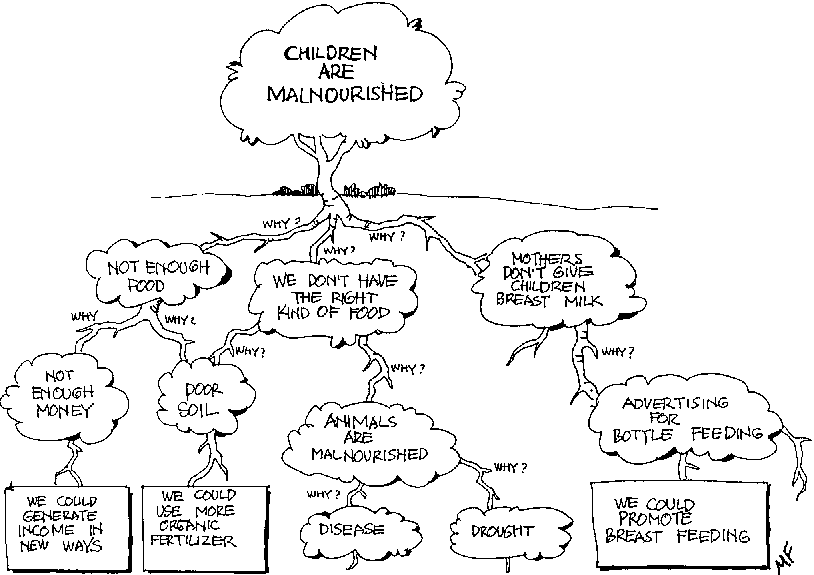
Problem Tree. Fox, H. (1989). Nonformal Education Manual. Washington, DC: Peace Corps/Information Collection and Exchange, #M0042.
Write down the root causes your communication strategy will address.
Output: Tailored Social Ecological Model
After determining the root causes and identifying the reasons for the differences between the shared vision and the current situation, an analysis is needed to thoroughly examine the context of the situation.Social Ecological Model 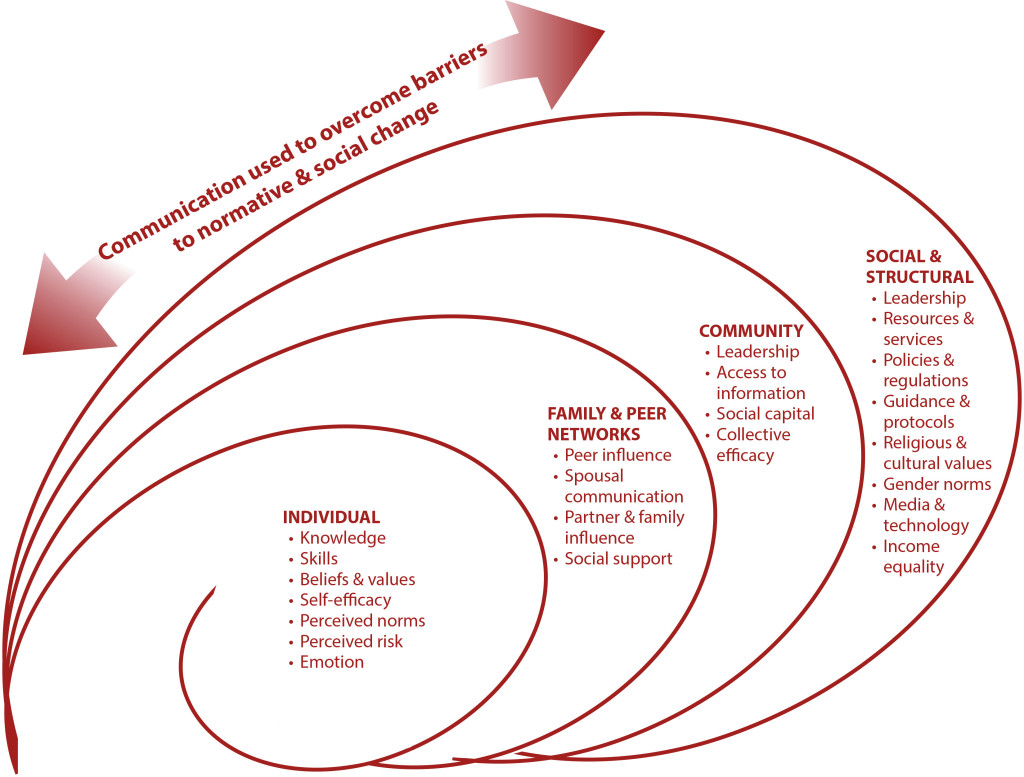
The Social Ecological Model can serve as a useful model for identifying the information needed for this analysis by examining the interconnected influences of family, peers, community and society on behavior. The social ecological perspective focuses on the various influences that can hinder or help in decision-making and in changing behaviors and/or social norms. The Social Ecological Model recognizes that behaviors take place within a complex web of social and cultural influences. This perspective views individuals as nested within a system of socio-cultural relationships—families, social networks, communities, nations—that are influenced by and have influence on their physical environments. Within the Social Ecological Model, individuals’ decisions and behaviors are understood to depend on their own characteristics, as well as the social and environmental contexts within which they live. The social and environmental contexts therefore influence individual behaviors relating to the identified challenge and root causes.
Examine the challenge’s context at each level in the Social Ecological Model. Keep in mind that while many of the questions at each level are similar, the answers will be different, depending on how each level is affected by the challenge.
Individual Level
- What is the incidence or prevalence? Severity?
- Who is affected?
- What knowledge and skills could improve the situation?
- What beliefs and values could improve the situation?
- What beliefs and values could hinder improvements?
- What are the perceived norms, risks, fears?
- What role does gender play?
- What are possible solutions? (individual behavior change as well as changes in beliefs, values and norms)
Family and Peer Network
- What are the effects on family? On peers?
- Who or what in the family influences behavior or social norms?
- Who or what in the peer network influences behavior or social norms?
- How does gender influence family and peer networks?
- What are possible solutions? (behavior change solutions as well as changes in gender norms, family dynamics)
Community
- What are the effects on the community?
- Who or what at the community-level influences behavior or social norms?
- Who or what in the community can facilitate change? Can hinder change?
- What services and/or products could help? Are they available? Accessible? Affordable? Acceptable?
- What communication resources are available?
- How does gender influence community?
- What are possible solutions? (communication solutions as well as changes in service delivery, products, gender norms, community leadership)
Society
- Who or what influences behaviors or social norms?
- What are the social, cultural and economic challenges?
- What social norms facilitate or hinder change?
- What policies facilitate or hinder change?
- What can support an enabling environment for social or behavior change?
- What are possible solutions? (changes in policy, changes in how leaders address the challenge, more equitable gender norms, equal access to services, advocating for structural change in terms of how services are provided and/or funds released)
Understanding the Context of the Core Challenge Example
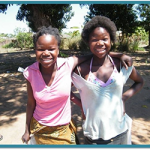 See how the Go Girls Initiative in Africa worked to understand their core challenge.
See how the Go Girls Initiative in Africa worked to understand their core challenge.
Output: Core challenge statement
This task uses a core challenge statement to sum up the challenge to be addressed and detail the key behaviors, social norms or policy needed to make the Shared Vision a reality.
- Begin by comparing the Shared Vision with the assessment of the situation.
- Then define the challenge in terms of the difference between the Shared Vision and the current situation.
The core challenge statement outlines key information on why there is a difference between the Vision (what you want to happen) and the current situation (what is happening now).
- What are the differences between the Shared Vision and the present situation?
- Why is there a difference between what you want to happen and what is happening now?
- What would happen if nothing was done to address the root causes or if conditions remained fundamentally the same?
- How can your communication strategy address the differences between your Vision and the present situation?
| Shared Vision | |
| Current Situation | |
| Differences between Vision and Situation | |
| Core Challenge Statement |
Download this chart as a Word document.
Summarizing the Core Challenge Example
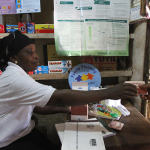 See how Nigeria's NURHI project summarized their core challenge.
See how Nigeria's NURHI project summarized their core challenge.
Process: Discussion and writing
Output: Program theory
What is a theory? A theory explains or predicts an event or situation, using systematic observation and inference. A program theory is your explanation of why you think your intended audience acts the way they do and your assumptions on how they will behave or change through exposure to your SBCC program.
Why is theory important in behavior change? SBCC programs based on social and behavioral science theories are more effective than those without a theoretical base. Choosing a theoretical base – your program theory – depends on the type of change needed as well as what drives your audience’s behavior. Behaviors vary, with some behaviors driven by individual preferences, needs or desires and others driven more by social pressures. Deciding to brush your teeth before bed would be based on an individual need, not smoking at a friend’s house would draw on social cues for behavior and a newlywed couple would be driven by social influences to become pregnant soon after settling in to married life. Other behaviors are driven by structural or contextual conditions such as access to resources, with availability of insecticide treated bed nets as an example.
Because behavior change is influenced by various factors, different theories can be utilized to address the factors that may pose obstacles to behavior change. If data indicate that the behavior you wish to promote is more individual in nature, then start by considering theories that are framed primarily at the individual level. If the intended behavior is more social in nature or more strongly determined by structural factors, then start your conceptual thinking from the perspective of a theory that primarily speaks to those levels.
The figure above indicates the primary emphasis of four theories commonly used in social and behavior change communication programs and how they fall roughly on the individual to structural continuum.
The Theory of Reasoned Action or Theory of Planned Behavior (TRA/TPB) focuses mainly on individual decision-making as a function of what you believe the consequences of a behavioral choice will be, whether those consequences are positive or negative, and what you think other people who are important to you think you should do. If the intended audience primarily acts by weighing the pros and cons of the behavior and are heavily influenced by what other people think about it, then TRA/TPB might be a good theory to use.
The Extended Parallel Processing Model (EPPM) is also primarily individual in nature, but emphasizes the motivating power of a perceived health threat, such as the idea that HIV/AIDS is a potentially deadly disease, to which one may or may not be susceptible. If you believe (correctly or incorrectly) that you are susceptible to a serious threat, then you are motivated to act. EPPM also emphasizes efficacy, which refers to what people feel they are able to do in response to a perceived threat. For example, if you believe that using condoms can prevent HIV (meaning, you believe that condoms work, called response efficacy) and also believe that you can successfully negotiate condom use with your partner (self-efficacy), then you are more likely to try and use condoms to prevent HIV. For behaviors that involve risk or threat, the EPPM model may be relevant as a program theory.
Examples of Each Condition According to Threat/Efficacy Beliefs
| High Efficacy
Beliefs that one is able to effectively avert a threat |
Low Efficacy
Beliefs that one cannot avert a threat, and even if s/he could, it wouldn’t work anyway |
|
| High Threat
Beliefs that one is at-risk for a significantly harmful threat |
Danger Control
People taking protective action against a health threat |
Fear Control
People in denial about health threat, reacting against it |
| Low Threat
Beliefs that a threat is irrelevant and/or trivial |
Lesser Amount of Danger Control
People taking some protective action, but not really motivated to do much |
No Response
People not considering the threat to be real or relevant to them; often not even aware of the threat |
Social Learning theory primarily focuses on individual self-efficacy, but it includes a more social aspect than TRA or EPPM, as it emphasizes how people learn from and copy the behaviors of those around them. If you observe a friend trying to change her exercise behaviors and see her struggle to maintain an exercise regimen but ultimately realize her exercise goals, then you are more likely to try the behavior yourself. You are also more likely to adopt the solutions to challenges that your friend demonstrated were successful (modeling). Modeling can also come from real or fictional characters depicted in mass media and on-line media. If the intended behavior is something people can see being practiced around them or is a behavior that is not commonly seen, but could be demonstrated and popularized by a “role model” selected by the program, then Social Learning may be a useful theory to use.
Finally, Diffusion of Innovations emphasizes how information is exchanged within social networks, such as a community, neighborhood, work group or peer group. The pattern of interpersonal relationships and interactions is an aspect of social structure. Exchange of information within a network is dependent on the connections within a community, access to communication channels, and access to resources including information resources. In this sense, diffusion is more structural and less individualistic in nature. If your intended behavior is more structural in nature, then diffusion might be a good theory to consider.
There are many, many theories available to health communication planners, each of which has a slightly different emphasis, as seen in the explanations of the four above. The key to using theory effectively is to identify a theory that seems to fit with your initial understanding of what currently influences behavior and social norms and to use that theory to explore in more detail the impetus for change. As you develop your program theory, don’t be afraid to drop a theory that doesn’t seem to work and try another one. Also, don’t hesitate to mix concepts from more than one theory if they seem to apply to the unique characteristics of your program and your audience. Formal academic theories are useful tools, but your goal should be NOT to select a formal theory, but to make your own program theory that matches the needs of your program.
Think of your program theory as a story that describes a sequence of connected events and characters, bounded in space and time, containing implicit or explicit suggestions about decisions, motives,barriers,and facilitators associated with an event.
For more information on theories used for SBCC: Making Health Communication Programs Work.
Determining Program Theory Example
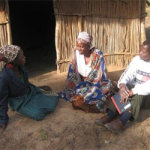 See how Mozambique's Tchova Tchova project determined what theory to use.
See how Mozambique's Tchova Tchova project determined what theory to use.
Process: Facilitated discussion using the Social Ecological Model, Ideational Model and Gender Lens
Output: Thorough understanding of who is affected by the challenge
Along with the situation analysis, a thorough examination of who is affected by the challenge and to whom communication efforts should reach provides valuable information on who the priority groups may be (and therefore who potential audiences may be) and gives insight on how to reach them.
Those most affected by the challenge may not always be the same group as those to whom communication efforts should be directed. For example, children under-five may be the most affected by diarrhea but the audience for communication efforts on the issue should be their parents and caregivers.
Your choice of program theory will determine how you analyze the individuals and groups you aim to reach. Determining common characteristics, applying a gender lens to your analysis, determining ideational factors such as attitudes, knowledge, self-efficacy and peer influence, and identifying the interconnected influences of family, peers, community and society on behavior will help you get to know your priority groups.
List common demographic characteristics of priority group(s)
Look for characteristics that differentiate those affected by the challenge from people who are not at risk or are not affected.
What do those affected have in common?
- Age range?
- Sex?
- Occupation?
- Residence? Rural? Urban?
- Number of children?
- Access to media?
- Wealth?
- Education?
- How do gender roles and gender relationships affect the challenge?
- How does gender inequity contribute to the challenge?
- What are the social norms and expectations of how men and women should behave?
- How are men and/or boys affected?
- How are women and/or girls affected?
- Who has decision-making power in regards to solutions?
- Are there differences in knowledge, attitudes and practices between men and women/boys and girls?
As you go through the remaining steps in this I-Kit, keep in mind how gender norms may affect the challenge and how men and women may react differently to your approaches.
Other Gender Resources:
The Gender Guide, IGWG Gender and Health Toolkit, Addressing the Role of Gender in the Demand for RMNCH Commodities: a Programming Guide, Manual for Integrating Gender into Reproductive Health and HIV Programs, Compendium of Gender Scales, and Engaging Men and Boys in Gender Equality and Health (Toolkit).
Describe Ideational Factors that influence those affected by the challenge
Ideation refers to new ways of thinking and the diffusion of those ways of thinking by means of social interaction in local communities. New ways of thinking are influenced by a combination of knowledge, attitudes, and discussion with others. The likelihood of someone adopting a new behavior or making steps towards a change in policy or social norms is much higher when a number of positive ideational factors are in play. Thus the motivation to adopt a new behavior is higher when a person:
- Has gained sufficient knowledge about it
- Has developed a positive attitude towards it
- Has talked to others about it
- And feels right about doing it
These four elements are interrelated. Increased knowledge improves attitudes; positive attitudes encourage a person to be more receptive to new information; and discussing with others leads to increased knowledge, more positive attitudes and more confidence in the proposed change. There is a cumulative relationship between the ideational elements. The more ideational elements people have, the greater the likelihood they will adopt the new behavior or intend to adopt it in the future .
Questions related to ideation and the priority group may include:
- What are their knowledge, values, and beliefs about the challenge?
- What are their emotions and feelings?
- What is their perceived risk?
- Do they feel able to make changes in their behavior (self efficacy)?
- Who provides them with social support?
- Who influences their behavior?
- What environmental factors support change?
- What environmental factors hinder change?
- What ideational factors influence your priority groups?
- How can these factors be used to best motivate change?
Determine Social Ecological Factors that Affect Priority Group(s)
You have already used the Social Ecological Model to understand the context of the challenge. The Social Ecological Model is also useful in collecting information about the priority group since barriers to change exist at multiple levels, not just at the individual level. Factors that may positively influence behavior are also found at multiple levels. Family and peer networks can directly influence those individuals affected by the challenge. Communities as well can directly and indirectly influence the behavior of those most affected. At the society-level, we find social norms, policies, and religious and cultural values that can influence individual behavior. Individuals do not behave alone. Rather, they are part of families, social networks, communities and nations and live within a physical environment, all of which influence behavior, values and the ability to change.
- What factors affect the priority group’s behavior? At the inter-personal level? At the community level? In their physical environment? Social network level? Society-level?
- What factors could encourage the priority group to make changes in behavior? At the inter-personal level? At the community level? In their physical environment? Social network level? Society-level?
Process: Facilitated discussion after background information has been gathered
Output: Description of communication capacity, SWOT analysis
This task helps determine the current communication landscape in terms of available resources and current communication activities.
Assess potential resources that can help you carry out the SBCC program:
- What communication resources and tools are available? How effective are the resources and tools in reaching priority groups?
- Are journalists currently reporting on the challenge? How is the priority group portrayed?
- Who are the key people in the priority group’s social networks who could introduce information and encourage behavior or social change?
- Are there media-use surveys of the priority group?
Determine what kinds of communication activities are currently being implemented to address the challenge:
- What communication efforts are on-going and through what communication approaches?
- How are these communication efforts perceived by the intended audience?
- How successful are/were the communication efforts in reaching the intended audience?
Identify communication capacity building needs for:
- Interpersonal communication and counseling
- Local media
- Digital and social media
- Community communication partners
An analysis of strengths, weaknesses, opportunities and threats (SWOT) within the current environment may facilitate the collection of this information. A SWOT analysis is applicable to all types of programs and assesses the internal (strengths and weaknesses) and external (opportunities and threats) factors that either facilitate or impede successful implementation.
| Strengths | What are your program’s strengths? What gives you an advantage over other programs? What do you do best? What communication and institutional resources do you have? |
| Weaknesses | In what areas (geographical, approaches, reach) are you weak? What makes you less capable than other programs? What resources do you lack? |
| Opportunities | What opportunities (other related communication programs, popular media venues) are available to you? What opportunities could you take advantage of? What external elements could help you reach your vision? |
| Threats | What might cause problems? What obstacles exist? What external elements could keep you from reaching your vision? |
Download this chart as a Word document.
Process: Facilitated discussion after background information has been gathered
Output: Table of services, products and capacity
If communication efforts increase demand, then services or products need to meet this increase. Without a strengthened link between demand and supply, those affected by the challenge will eventually become ambivalent towards demand generation messages.
Ask personnel from the programs or services that will be promoted:
- Can their capacity meet increased demand?
- Will they be able to handle additional clients?
- Will enough supplies be available on a regular basis?
- Will SBCC efforts create expectations that can be met?
Draft table outlining a plan to address increased demand:
| Increased Demand for: | Plan to Meet Demand: |
|---|---|
| Services: | |
| Personnel: (skills, capacity, time) | |
| Supplies: |
Process: Facilitated discussion after background information has been gathered
Output: Table of partners at each level
Task 9 helps gather information on potential partners and collaborators and their capacity-building needs.
Determine what skills and resources will be needed from program partners.
- Who has national-level advocacy experience?
- Who has experience establishing networks and maintaining momentum on social challenges?
- Who has experience producing health promotion materials?
- Who can produce television or radio programs?
- Who can organize training activities?
- Who can mobilize communities to address the problem?
Identify specific partners and allies to help initiate policy change and strengthen the enabling environment at the national level.
- What would motivate their participation?
- In what skills area would they need capacity building?
Identify partners who can collaborate with you on implementing activities at the community level. Partners could include field workers, schools, health service providers, community-based groups, networks/associations of communication organizations and individuals or groups affected by the challenge.
- What would motivate their participation?
- In what skills area would they need capacity building?
For detailed guidelines on how to involve individuals or groups affected by the challenge and other stakeholders, refer to Participation Guide: Involving Those Directly Affected in Health and Development Communication Programs.
| Potential Partners | Level(national, local) | Required Skills (Will capacity building be needed?) |
Required Resources (Will additional resources be needed?) |
Final Output for Step 1
Situation Analysis Document with Appendices
- Consolidate thinking and tools from Step 1 tasks
- Summarize the main points of Step 1:
- What is the vision? (Shared Vision statement)
- What is the challenge and its root causes? (Core Challenge statement)
- What is the program theory?
- Who is most affected by the challenge or most at risk of the challenge? (priority group(s))
- Who influences the priority group(s)?
- What changes in behavior would improve the situation? Changes in social norms? Changes in policy?
- What are the key challenges to change?
- What are the main facilitators for change?
- What are the communication needs and resources?
- What is the capacity of services and products to meet increased demand?
Refer to the Situation Analysis for Steps 2 to 7 to inform strategy development.

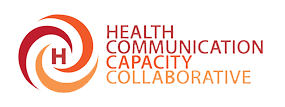
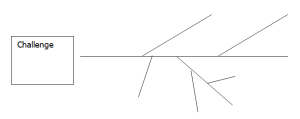

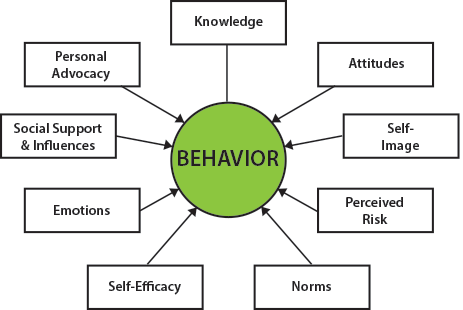
No Comments